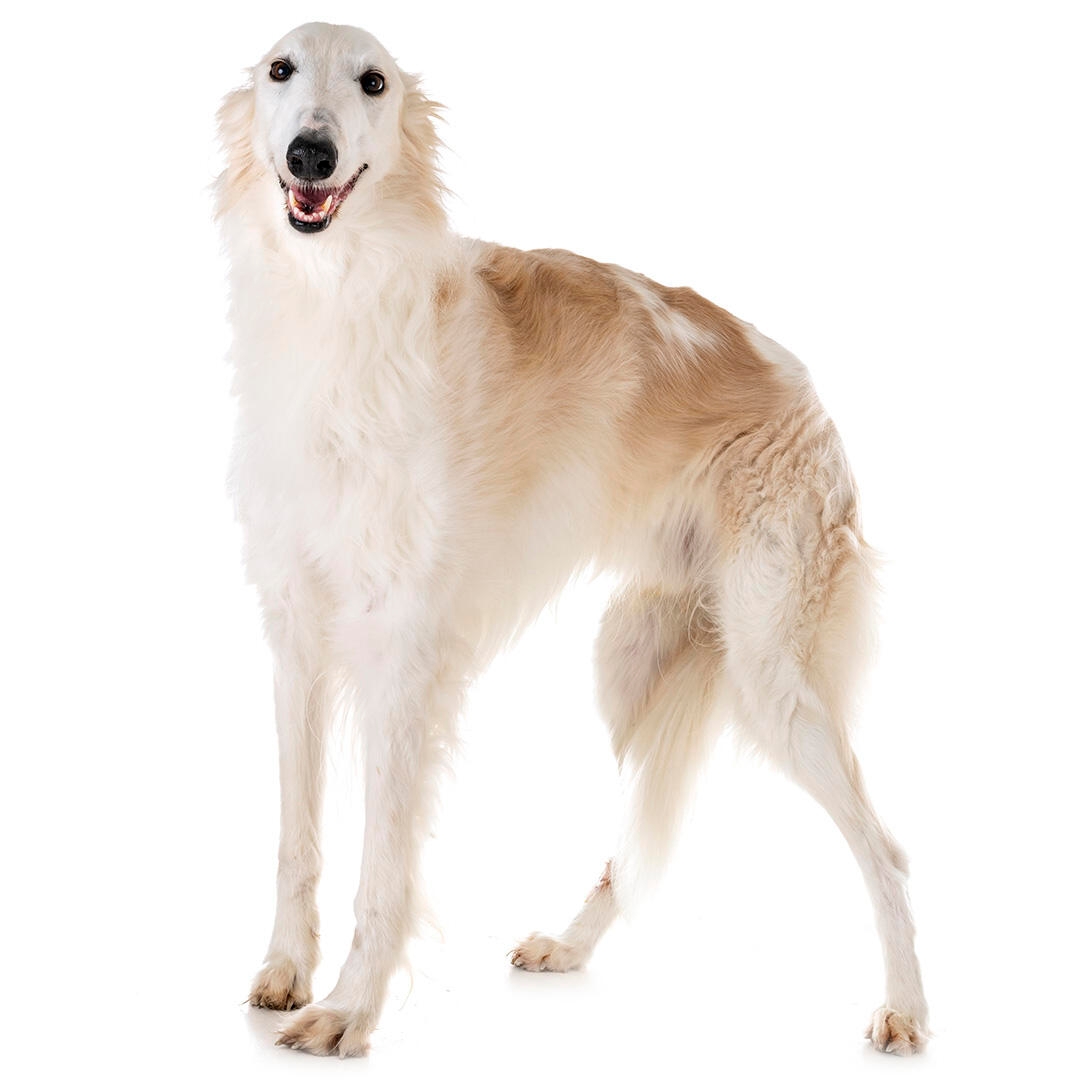
| Family-friendly: | 4/5 |
| Exercise needs: | 2/5 |
| Easy to train: | 3/5 |
| Tolerates being alone: | 1/5 |
| Likes other pets: | 3/5 |
| Energy level: | 2/5 |
| Grooming needs: | 4/5 |
| Shedding: | 5/5 |
The Borzoi breed can suffer from:
- Degenerative myelopathy, which is a progressive disease affecting the spinal cord.
- Thyroiditis¹ which can lead to hypothyroidism where the thyroid gland is underactive and does not product enough thyroid hormone, and can result in low energy levels, weight gain and skin problems.
- Dental problems due to the breed's jaw conformation.
Priority Kennel Club health schemes and testing:
None but there are several recommended schemes that the Kennel Club recommends which can be found here.
¹D. H. Conaway, 'Clinical and histological features of primary progressive, familial thyroiditis in a colony of borzoi dogs', 1985, Vet Pathology.
As an adult, the Borzoi is a good-natured and gentle dog in the house, taking up surprisingly little space for their size when it suits them. Aloof and reserved with strangers, they can be very affectionate with their own family and exhibit a sense of humour and strong personality that sighthound fans find very appealing.
While not a guard dog, they may alert owners to the presence of suspicious characters and will give good account of themselves if they feel it necessary. Their nature as a sighthound, to course and to chase, must be kept in mind. While they can be raised with cats and small dogs that they view as ‘family’, they will always be predisposed to give chase to fast moving furry objects.
| Family-friendly: | 4/5 |
| Exercise needs: | 2/5 |
| Easy to train: | 3/5 |
| Tolerates being alone: | 1/5 |
| Likes other pets: | 3/5 |
| Energy level: | 2/5 |
| Grooming needs: | 4/5 |
| Shedding: | 5/5 |
As with many breeds, there is some dispute as to the origins of the Borzoi. However, it is likely that Greyhound-like dogs from ancient Egypt were crossed with the native heavier coated herding and pastoral breeds from northern Russia to produce the Borzois ancestors.
From the 16th Century onwards the breed became refined into the ultimate wolf catching sighthound, working in pairs to bring down a wolf and hold it until a mounted hunter could dispatch the quarry.
Borzois were valued highly by the Czars of Russia, who gifted them frequently to other nobility around Europe, and it is these gifted dogs who saved the breed following the Russian Revolution of 1917, when the breed almost died out.
Fit, active, possessing a strong sense of humour and the patience necessary to explain what this breed is to everyone you meet. They’re unusual, and that won’t go unnoticed! The Borzoi needs someone who understands their sensitivity and can handle their clownish (sometimes thuggish in adolescence) moments equally well. You’ll also need to enjoy grooming, long walks and endless training for a recall that even then will have around a 50% success rate!
Adult Borzois will be happy with an hour or more’s walking each day, ideally with freedom to run in secure spaces. Younger Borzois must not be over exercised but still need frequent shorter walks and mental stimulation to avoid boredom.
Always keep in mind that a sighthound can see movement from some distance and will be inclined to hunt and chase moving objects, and even in play, their play style will involve mock ‘coursing’ which other dogs may find rather off-putting.
Borzoi is a large breed dog, and whilst they can curl up small when they want to, they do require space to stretch out, a garden suitable for running in and to live within easy reach of secure running space.
Due to the time it takes these dogs to mature, Borzois are not suited to going up and down stairs frequently.
Large breed dogs, as well as having large appetites, benefit from a different balance of nutrients including minerals and vitamins compared to smaller-breed dogs. The Borzoi is prone to bloating and stomach problems; smaller, more frequent meals can help minimise this risk.
The Borzoi’s silky, wavy coat will need regular brushing and combing several times a week, with paw pads checked daily for foreign objects and the hair there trimmed down. Due to their size, professional dog grooming may be required for full bathing and drying. Borzois will shed hair, particularly during seasonal moults.
Training the Borzoi requires patience and understanding what motivates them to want to work with you. They will always find running and chasing rewarding, so use this to your advantage where possible, and make training recall a priority, even though it is not advisable to let a Borzoi off lead in an unsecured area.
This is not a dog who is likely to enjoy dog training for the sake of training itself. Careful management is needed, as well as training ‘as you go along’ rather than specific training sessions.
The well-trained adult Borzoi can be an excellent family dog, however the immature puppy and adolescent Borzoi may be too exuberant and bouncy for very small children or frail older people. Like all larger breeds, they take some time to grow and mature and need careful management during this time.
While many dogs are traditionally thought of as being good with children, all dogs and children need to be taught to get on with each other and be safe together. Even so, dogs and young children should never be left alone together and adults should supervise all interactions between them.